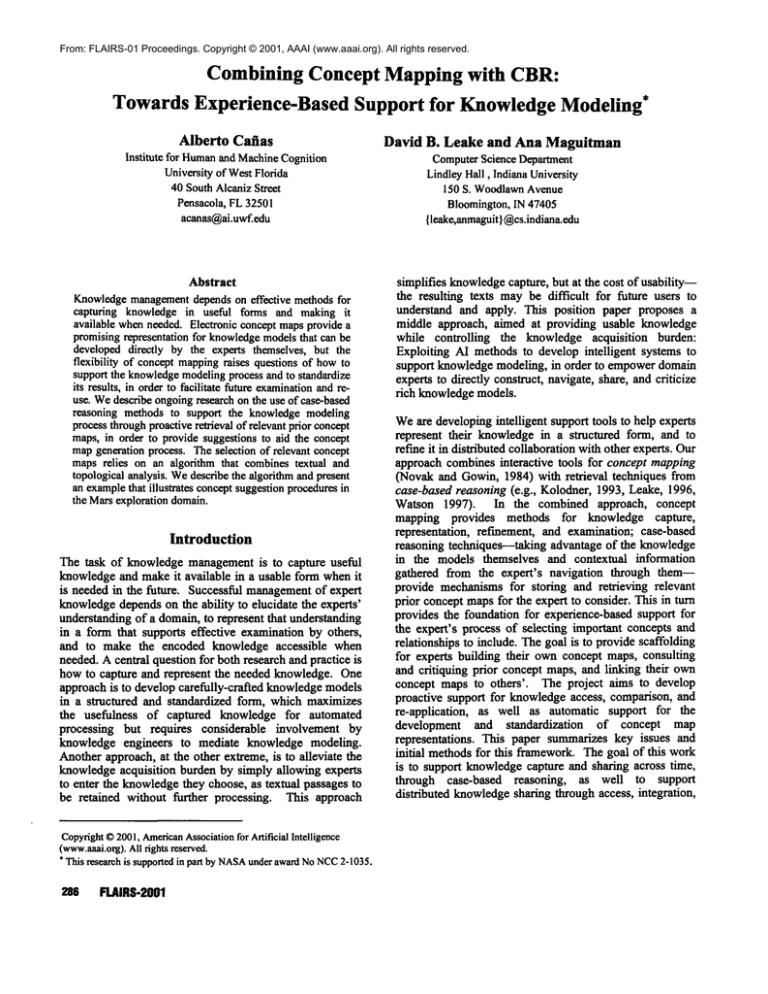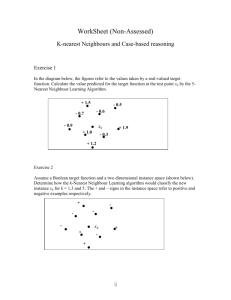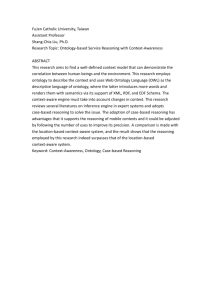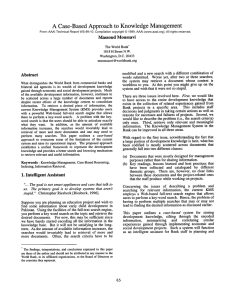
From: FLAIRS-01 Proceedings. Copyright © 2001, AAAI (www.aaai.org). All rights reserved.
Combining Concept Mapping with CBR:
Towards Experience-Based Support for Knowledge Modeling*
Alberto Cafias
Institute for Human
andMachine
Cognition
Universityof WestFlorida
40SouthAlcanizSWeet
Pensacola,FL32501
acanas@ai.uwf.edu
Abstract
Knowledge managementdepends on effective methods for
capturing knowledge in useful forms and making it
available when needed. Electronic concept maps provide a
promising representation for knowledgemodels that can be
developed directly by the experts themselves, but the
flexibility of concept mappingraises questions of how to
support the knowledgemodelingprocess and to standardize
its results, in order to facilitate future examinationand reuse. Wedescribe ongoing research on the use of case-based
reasoning methods to support the knowledge modeling
process through proactive retrieval of relevant prior concept
maps, in order to provide suggestions to aid the concept
map generation process. The selection of relevant concept
maps relies on an algorithm that combines textual and
topological analysis. Wedescribe the algorithm and present
an examplethat illustrates concept suggestion procedures in
the Mars exploration domain.
Introduction
The task of knowledgemanagement
is to capture useful
knowledgeand makeit available in a usable form whenit
is neededin the future. Successfulmanagement
of expert
knowledge
dependson the ability to elucidate the experts’
understandingof a domain,to represent that understanding
in a form that supports effective examinationby others,
and to make the encoded knowledge accessible when
needed.Acentral questionfor both researchandpractice is
howto capture and represent the needed knowledge.One
approachis to developcarefully-crafted knowledgemodels
in a structured and standardized form, whichmaximizes
the usefulness of captured knowledgefor automated
processing but requires considerable involvement by
knowledgeengineers to mediate knowledgemodeling.
Anotherapproach,at the other extreme,is to alleviate the
knowledgeacquisition burdenby simply allowing experts
to enter the knowledge
they choose,as textual passagesto
be retained without further processing. This approach
Copyright
©2001,American
Association
forArtificialIntelligence
(www.aaai.org).
Allrightsreserved.
* Thisresearchis supported
in partbyNASA
underaward
NoNCC
2-1035.
286
FLAIRS-2001
David B. Leake and Ana Maguitman
Computer
ScienceDepartment
LindleyHall,IndianaUniversity
150 S. Woodlawn
Avenue
Bloomington,
IN 47405
{ leake,anmaguit
} @cs.indiana.
edu
simplifies knowledge
capture,but at the cost of usability-the resulting texts maybe difficult for future users to
understand and apply. This position paper proposes a
middle approach, aimedat providing usable knowledge
while controlling the knowledgeacquisition burden:
Exploiting AI methodsto developintelligent systemsto
support knowledgemodeling,in order to empower
domain
expertsto directly construct,navigate,share, andcriticize
rich knowledgemodels.
Weare developing intelligent support tools to help experts
represent their knowledge in a structured form, and to
ref’me it in distributed collaboration with other experts. Our
approach combines interactive
tools for concept mapping
(Novak and Gowin, 1984) with retrieval
techniques from
case-based reasoning (e.g., Kolodner, 1993, Leake, 1996,
Watson 1997). In the combined approach,
concept
mapping provides
methods for knowledge capture,
representation,
refinement, and examination; case-based
reasoning techniques-taking
advantage of the knowledge
in the models themselves and contextual
information
gathered from the expert’s navigation through them-provide mechanisms for storing and retrieving relevant
prior concept maps for the expert to consider. This in turn
provides the foundation for experience-based support for
the expert’s process of selecting important concepts and
relationships to include. The goal is to provide scaffolding
for experts building their own concept maps, consulting
and critiquing prior concept maps, and linking their own
concept maps to others’.
The project aims to develop
proactive support for knowledge access, comparison, and
re-application,
as well as automatic support for the
development
and standardization
of concept map
representations.
This paper summarizes key issues and
initial methods for this framework. The goal of this work
is to support knowledge capture and sharing across time,
through case-based
reasoning,
as well to support
distributed knowledge sharing through access, integration,
Case-based
knowledge
management
systems
oRencapture
information
in purelytextual
form.Thisfacilitates
knowledge
capture,
butmayobscure
thestructure
of the
models
beingrecorded,
making
it difficult
to identify
or
Background
compare
keyfactors
andrelationships.
Othersystems
use
carefully-crafted
structured
representations,
atthecostof
Case-based reasoning is the process of learning and
requiring
significant
intervention
andeffort
byknowledge
reasoning
by capturing
andreusing
lessons
fromanalogous engineers.
We arcinvestigating
concept
maps(Novakand
priorexperiences
(Kolodner,
1993).Theproficiency
Gowin,1984)as a mediumforknowledge
modelsthatarc
case-based
reasoners
comesfromhaving
therightcases,
useful
butalsotractable
fortheexperts
themselves
to
being
abletoaccess
themattheright
times,
andbeing
able
build.
Concept
mapping
is designed
to tapintopeople’s
to applythemin therightways.Because
humanexperts
internal
cognitive
structures
andexternalize
concepts
and
frequently
remember,
gather,compare,
and reasonfrom
propositions.
A
concept
map
is
a
graphical
display
of
specific
examples,
theyoftenfredCBRto be a natural
conceptnamesconnectedby directedarcsencoding
methodforsupporting
knowledge
capture
andsharing.
As
propositions
in theformof simplified
sentences.
Whena
additional
experiences
or lessons
arestoredin theCBR
concept
mapis generated
in an electronic
form,nodesin
system,
theyforma growing
corporate
memoryto capture
theconcept
mapmayalsobe associated
withmultimedia
collective
experience
andmakeit available
whenneeded
in
information
tosupplement
andclarify
itstext,
asillustrated
thefuture.
Case-based
reasoning
isreceiving
considerable
in
the
sample
concept
map
shown
in
Figure
I. Concept
currentattention
in knowledge
management
andlessons
maps
appear
similar
to
semantic
networks
and
conceptual
learned
systems
(fora sampling
ofpapers
onthissubject,
graphs,
butarenotconstrained
bysyntactic
rules
andhave
seeAhaet al.(1999)
andAha& Weber(2000)).
no associated
semantics.
They weredevelopedas a
and comparisonof concept maps, cases, and other forms of
multimediainformation across the Internet.
..;."
...
.:
:.::.
generated
’
by
Figure 1 A concept mapfor the Marsexploration domain.
KNOWLEDGE
MANAGEMENT287
pedagogic device for use by humans "sketching out"
concepts, rather than as a formal device for use by
reasoning engines, and have received much use in
educational settings for elucidating,
sharing, and
comparing knowledge.
concept maps, despite differences in their layouts. CBR
research provides a wealth of approaches to build on for
retrieving cases with structured representations. Because
of the computational cost of matching structured
representations, one promising methodis to use a two-step
process: inexpensive prefiltering
to select likely
Electronic concept mapsprovide an elegant representation
candidates, followed by more subtle (and expensive)
of an expert’s domainknowledgein a browsable, shamble
analysis of the selected cases (Gentner, Forbus and Law
form, easily understood by others, and the "informal"
1995). To summarize features for inexpensive initial
nature of concept maprepresentations enables them to be
matching we are investigating
approaches based on
generated by the experts themselves. This makes them a
Kleinberg’s (1998) algorithms for topological analysis
strong candidate methodfor direct entry, examination, and
graphs (previously applied to identify important nodes on
sharing of experts’ knowledge. For example, concept
the web), which efficiently infer features such as "hub
mapping tools from the Cognition Institute
at the
nodes," or "centers of activity." These nodes can be
University of West Florida (http://cmap.coginst.uwf.edu)
computedat storage time for each concept map, to provide
havebeenusedforapplications
suchas thecreation
at
a weighted set of concepts to describe each map. These
NASAof a large-scale
multimedia
CD and websiteon
sets can then be matchedagainst the current map, for fast
Mars(http://cmex.arc.nasa.gov/cmaps/Mars2000)
(Figure
filtering to find mapswith similar importantconcepts.
1 showsan example
fromthisCD).Thesetoolsalready
providethe capabilityfor distributed
knowledge
ApplyingTopological Analysis to ConceptMaps
construction
and accessovertheInternet,
but they
Topological
analysis
canbe applied
to theanalysis
of
currently
provide
no automated
support
forretrieval
of
concept
maps
to
describe
the
relative
arrangements
of
their
relevant
prior
concept
mapsorother
intelligent
support
for
concepts. The hypotheses underlying our use of this
theconcept
mapgeneration
process.
method
are(1)thatthetopology
of theconcept
mapcan
convey
usefulinformation
to determine
theroleof each
concept
in thewholemap,and(2)thatthetopological
Towards Proactive
Concept Map Retrieval
rolesof concepts
in themapcanbe usefully
summarized
Relevant prior concept mapscan be a valuable resource to
according to a small set of dimensions. Our
the user who is capturing new knowledge, reffming old
characterization
schemedescribes
concepts
according
to
conceptualizations, or seeking to better understand a
four node types:
domain. In our view, the effectiveness of concept map
Authorities are concepts to which other concepts
retrieval tools dependson their ability to anticipate which
concept maps are relevant and automatically present them
converge. Theyare the nodes that have the largest
to users when needed. Simply providing users with a
number of incoming links arriving from "hub
query facility is insufficient: As has previously been
nodes."
¯ Hubs(centers of activity) are the concepts that
observed by ourselves and others, users maynot use the
query facility, in order to avoid the effort of querying, or
have the largest numberof outgoing links ending
at "authority nodes."
maymissuseful
information
bynotquerying
at theright
¯
Upper Nodes generally correspond to those that
times.
appear at the top of the mapwhenit is presented
ina graphical
representation.
Ingeneral
thereis
Retrieval Issues and Approach
onemainconcept
in eachconcept
mapspecifying
The success of proactive retrieval methodsdependson the
themaintopic.
availability of contextual information (e.g., Budzik and
¯ LowerNodesaregenerally
theonesthatappear
at
Hammond,2000), making context extraction a crucial
thebottomof the concept
map in a graphical
issue. We are investigating
the hypothesis that by
representation.
monitoring the use of concept mappingtools and the user’s
navigation through existing maps, it is possible to gather a
Weassociate to eachconcept four weights, a-weight, hrich body of contextual information to guide retrievals.
weight, u-weight and l-weight representing the degree to
Ourprevious
workhasgivenpromising
results
on using
which the concept belongs to the categories mentioned
concept
mapinformation
to focusretrieval
in a domainabove. Once these weights are computed, they remain
specific
retrieval
application
(Cafias
etal.,
1999).
static unless the topology of the concept map changes.
Thus each concept’s role in a concept map can be
A central issue for concept map retrieval is how to
characterized using only its associated weights, and the
recognize the similarity of related concept. Related
roles concepts play in different mapscan be comparedby
concept maps can be represented in manydifferent ways,
comparingtheir weights.
requiring the similarity assessment/retrieval process to
efficiently recognize the similarity between isomorphic
288
FLAIRS-2001
Cmap Concept Description
Algorithm
Wehave developed an O (n 3) algorithm for characterizing
concept mapnodes, and are nowtesting it with promising
results. This algorithm calculates weightsas follows:
I. For each concept c in the set of concepts CMap,
set a-weight(c)=l, h-weight(c)=l, u-weight(c)=l,
and 1-weight(c)=
2. Normalize weights such that
E w(c)2 = 1
ca CMap
3. Compute
h-weight(p)
= E a-weigh
5.
(q)
Normalizeh-weights as described in step 2.
Compute
a-weight (p) = E h-weight (q)
( q,p )c:Link$
Normalizea-weights as described in step 2.
7.. Repeat steps 3 to 6 until a fixed point for the
functions a-weight and h-weight is reached. This
requires at most[Cmap[iterations.
8. Compute
1 if --,3(q, p) ~ Links
u-weight(p) = ~ E u-weight(q)2 otherwise
[ ( q,p)~.Link.¢
Normalizeu-weights as described in step 2.
.
10.
Repeat steps 8 and 9 until a fixed point for the
function u-weight is reached.
11. Compute
1 if ~3(p,q) ~ Links
l-weight
for Retrieval
Given the characterizations of the individual concepts in a
map, we obtain the similarity degree between two concept
maps mI and m2 by comparing them as follows. First, we
use simple keyword comparisons of node labels to
calculate a similarity value used to determine howclosely
individual nodes in the two mapscorrespond to each other,
by the following formula:
Kw(ml,m2)
= Elkp
nkq I*w(p)*w(q)
( p.q)E ml2
wherek, and ~ represent the sets of keywordsassociated to
the concepts p and q respectively.
( p,q)E Links
.
Using the Concept MapDescriptions
f
(p) = ] E I-weight (q)2 otherwise
[ ( p,q)~ Links
12. Normalizel-weights as described in step 2.
13. Repeatsteps 11 and 12 until a fixed point for the
function l-weight is reached.
This algorithm is based on the scheme presented by
Kleinberg (1998), which associates weights to nodes
terms of their roles as authorities or hubs. However,it
adds the calculation of two additional weights, u-weights
and l-weights, which, as mentioned earlier, reflect the
relative position of a conceptin a graphical representation.
These provide important information for comparing
concept maps, because nodes higher in the concept map
representation tend to be associated with the topic of the
concept map.
Finally, the similarity metric S between entire concept
mapsis computedas follows: I
S(ml,m2 )
E Cw * K’w(ml,m2)
wE{ a- weight,h- weight,
u- weight,I- weight}
where the values associated to the %’s determine in which
weight categories we want to focus. For example, we can
set ca.,~,g~0.5,c~.,~fhr~0.5,c~,~r=0,and C~-,,,gh~O
if wewant
to stress matchesbetweenconcepts that have a higher rank
as authorities or hubs.
Based on the described similarity metric the test system
retrieves a set of mapssimilar to the target. Asdiscussed in
the following section, correspondences between individual
nodes in similar mapssuggest specific concepts relevant to
those currently being edited by the user, enabling the user
to suggest links from those concepts as possibilities for
new links in the current map.
Applying Proactive Retrieval to Aid
Generation of Sharable, High-Quality
Concept Maps
The concept mappingprocess is intended to give maximal
freedom to clarify and communicate the expert’s
potentially idiosyncratic understanding. However, this
leaves the user with little guidance about howto build a
concept map,increasing user effort and complicating later
retrievals due to diverging representations for similar
concepts. Automatic retrieval of relevant prior concept
maps can help alleviate this problem, by presenting
suggestions based on similar maps during concept map
generation. Wesee this methodas playing two main roles:
Helping guide the user towards (1) possible factors
consider and (2) candidate terminology to use for those
factors.
Using the previous retrieval techniques, we have been
testing link and concept suggestion procedures in the Mars
domain, using a body of over 150 concept maps on Mars
as a sample case base. Given a concept map in progress,
KNOWLEDGE
MANAGEMENT289
i~
progressed
to
I
include
address
/
future
S¢ieMe
: ,,.Goals
..
carry
Figure 2 A partial concept mapfor the Marsdomain.
our test system automatically retrieves similar prior
concept maps, and suggests links and nodes from those
maps for the user to consider adding to the current map.
For example, for the sample mapshown in Figure 2, and
the active node "Space missions to Mars," the system
suggests five additional links and the concepts that they
point to in similar prior maps, to give ideas for possible
additions. The links are "include ---> Russian and other non
USmissions," "are aiming toward ---> sample return," "can
be launchedevery ---> 26 mouths," "will eventually lead to
---> humanexploration," and "may include ---> airborne
platforms." Each of these suggests types of elaborations
that may be relevant to the development of the new
concept map.
Conclusion
This paper describes ongoing research on applying casebased reasoning techniques to proactively retrieve relevant
prior concept maps and provide suggestions during the
knowledge modeling process, to support experts as they
directly build, share, compare, and revise rich knowledge
models represented as concept maps. Integrating concept
mapping and CBRpromises benefits in increasing the
practicality of capturing rich knowledge, by helping to
share knowledge relevant to the knowledge modeling
process and suggesting concepts and links to consider. In
addition, by facilitating
access to relevant stored
knowledgemodels, it can provide the opportunity to ref’me
prior knowledge models in light of new lessons and
perspectives.
References
Aim, D., Becerra-Fernandez, I., Maurer, F., and MufiozAvila, H. 1999. Proceedings of the AAA1-99Workshopon
Exploring Synergies of Knowledge Managementand CaseBased Reasoning. AAAI Press, Menlo Park, CA.
29O
FLAIRS-2001
Aha, D., and Weber, R. 2000. Proceedings of the AAAI2000 Workshop on Intelligent Lessons Learned Systems.
AAAIPress, Menlo Park, CA.
Ausubel, D., Novak J., and Hanesian, H. 1978.
Educational psychology: A Cognitive View. NewYork:
Werbel & Peck, 1986.
Budzik, J., and Hammond,
K. 2000. User interactions with
everyday applications as context for just-in-time
information access. In Proceedings of the 2000
International Conferenceon Intelligent User Interfaces,
pp. 44-51.
Cafias, A., Leake, D., and Wilson, D. 1999. Managing,
mapping, and manipulating conceptual knowledge. In
Proceedings of the AAAI-99 Workshop on Exploring
Synergies of Knowledge Management and Case-Based
Reasoning, pages 10-14, MenloPark, 1999. AAAIPress.
Forbus, K., Gentner, D., and Law, K. 1995. MAC/FAC:
A modelof similarity-based retrieval. Cognitive Science,
19:141-205.
Kleinberg, J. 1998. Authoritative Sources in a Hyperlinked
Environment. In Proceedings of the 9’h Annual ACMSIAMSymposiumon Discrete Algorithms, pp. 668-677.
Kolodner, J. 1993. Case-Based Reasoning.
Kaufmann, San Mateo, CA.
Morgan
Leake, D. 1996. Case-Based Reasoning: Experiences,
Lessons, and Future Directions. AAAIPress, MenloPark,
CA.
Novak, J. D., and Gowin, D. B. 1984. Learning Howto
Learn. CambridgeUniversity Press, NewYork.
Watson, I. 1997. Applying Case-Based Reasoning:
Techniques for Enterprise Systems. Morgan Kaufmann,
San Francisco.






